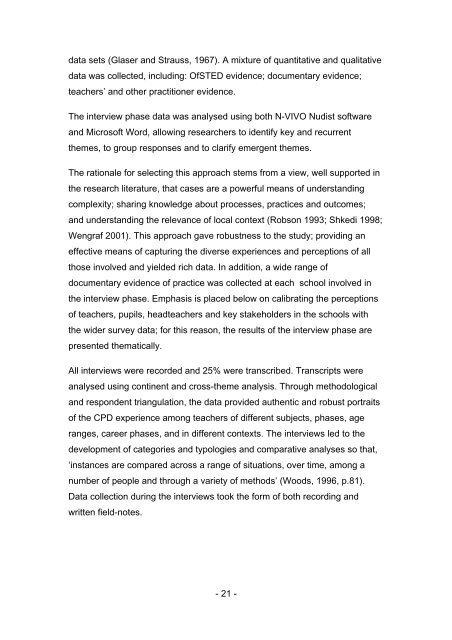Evaluating the Impact of Continuing Professional Development (CPD)
Evaluating the Impact of Continuing Professional Development (CPD)
Evaluating the Impact of Continuing Professional Development (CPD)
Create successful ePaper yourself
Turn your PDF publications into a flip-book with our unique Google optimized e-Paper software.
data sets (Glaser and Strauss, 1967). A mixture <strong>of</strong> quantitative and qualitative<br />
data was collected, including: OfSTED evidence; documentary evidence;<br />
teachers’ and o<strong>the</strong>r practitioner evidence.<br />
The interview phase data was analysed using both N-VIVO Nudist s<strong>of</strong>tware<br />
and Micros<strong>of</strong>t Word, allowing researchers to identify key and recurrent<br />
<strong>the</strong>mes, to group responses and to clarify emergent <strong>the</strong>mes.<br />
The rationale for selecting this approach stems from a view, well supported in<br />
<strong>the</strong> research literature, that cases are a powerful means <strong>of</strong> understanding<br />
complexity; sharing knowledge about processes, practices and outcomes;<br />
and understanding <strong>the</strong> relevance <strong>of</strong> local context (Robson 1993; Shkedi 1998;<br />
Wengraf 2001). This approach gave robustness to <strong>the</strong> study; providing an<br />
effective means <strong>of</strong> capturing <strong>the</strong> diverse experiences and perceptions <strong>of</strong> all<br />
those involved and yielded rich data. In addition, a wide range <strong>of</strong><br />
documentary evidence <strong>of</strong> practice was collected at each school involved in<br />
<strong>the</strong> interview phase. Emphasis is placed below on calibrating <strong>the</strong> perceptions<br />
<strong>of</strong> teachers, pupils, headteachers and key stakeholders in <strong>the</strong> schools with<br />
<strong>the</strong> wider survey data; for this reason, <strong>the</strong> results <strong>of</strong> <strong>the</strong> interview phase are<br />
presented <strong>the</strong>matically.<br />
All interviews were recorded and 25% were transcribed. Transcripts were<br />
analysed using continent and cross-<strong>the</strong>me analysis. Through methodological<br />
and respondent triangulation, <strong>the</strong> data provided au<strong>the</strong>ntic and robust portraits<br />
<strong>of</strong> <strong>the</strong> <strong>CPD</strong> experience among teachers <strong>of</strong> different subjects, phases, age<br />
ranges, career phases, and in different contexts. The interviews led to <strong>the</strong><br />
development <strong>of</strong> categories and typologies and comparative analyses so that,<br />
‘instances are compared across a range <strong>of</strong> situations, over time, among a<br />
number <strong>of</strong> people and through a variety <strong>of</strong> methods’ (Woods, 1996, p.81).<br />
Data collection during <strong>the</strong> interviews took <strong>the</strong> form <strong>of</strong> both recording and<br />
written field-notes.<br />
- 21 -

















